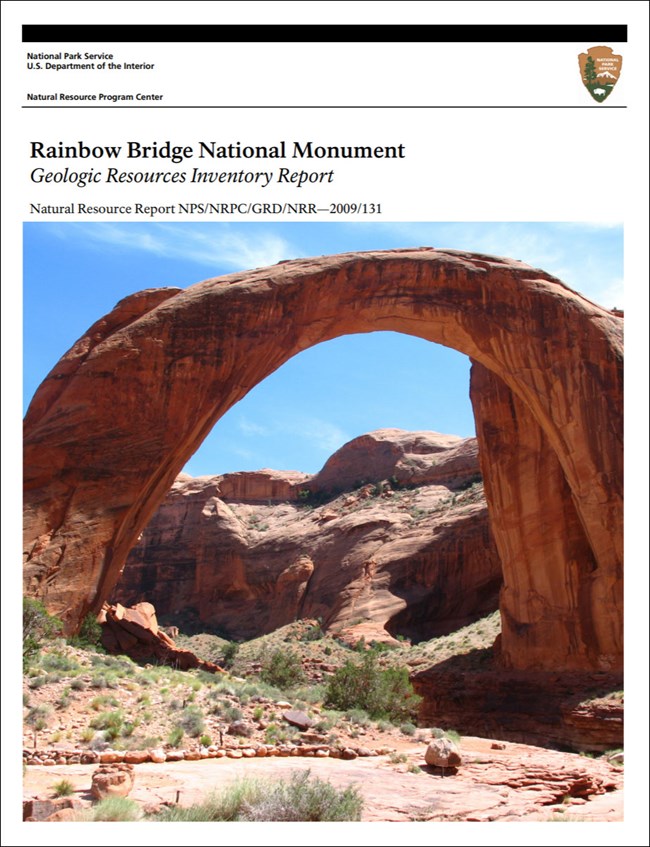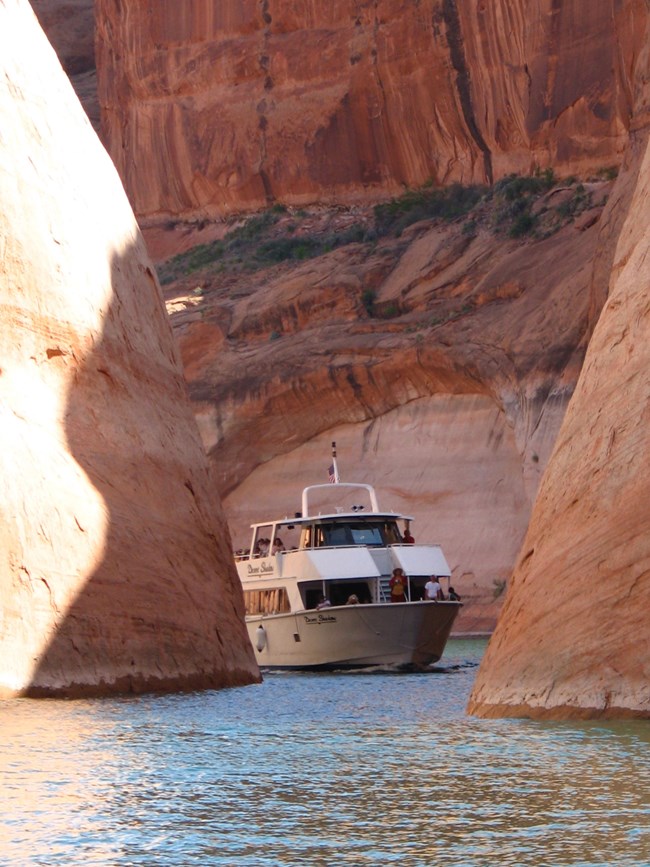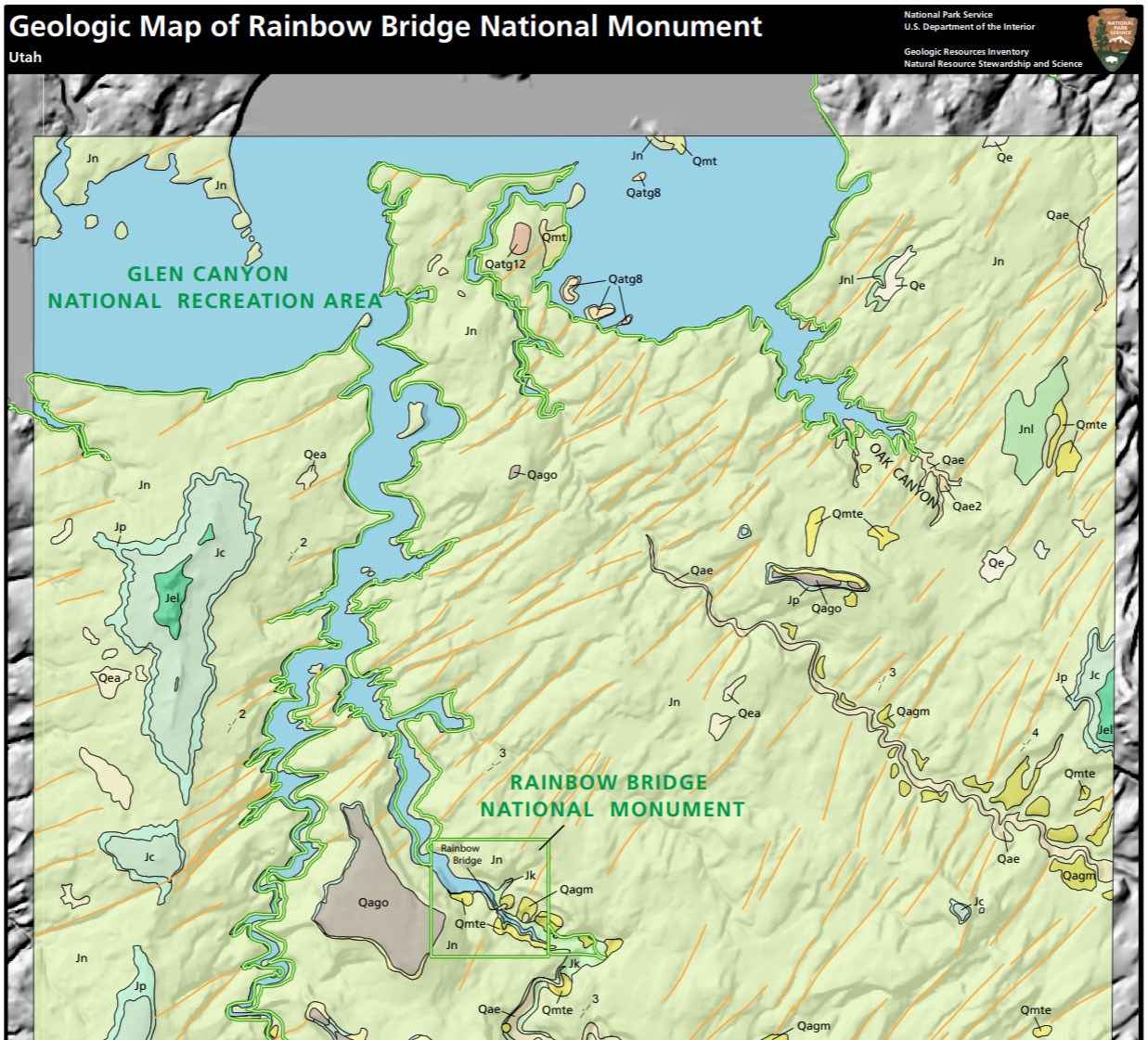Last updated: July 15, 2024
Article
NPS Geodiversity Atlas—Rainbow Bridge National Monument, Utah
Geodiversity refers to the full variety of natural geologic (rocks, minerals, sediments, fossils, landforms, and physical processes) and soil resources and processes that occur in the park. A product of the Geologic Resources Inventory, the NPS Geodiversity Atlas delivers information in support of education, Geoconservation, and integrated management of living (biotic) and non-living (abiotic) components of the ecosystem.

Introduction
Rainbow Bridge National Monument is located in a southern canyon arm of Lake Powell adjacent to Glen Canyon National Recreation Area in San Juan County, southern Utah. Established on May 30, 1910, Rainbow Bridge contains 105 hectares (160 acres) and protects one of the world’s largest natural bridges that rises 88 m (290 ft) above the canyon floor. Situated approximately 13 km (8 mi) upstream from the confluence of Bridge Creek with the Colorado River, Rainbow Bridge lies in remote canyon country. The formation of Rainbow Bridge is the result of continuous stream erosion that has slowly carved the bridge completely out of sandstone over many years. The natural bridge is considered sacred to several American Indian tribes, including the Hopi Tribe, Kaibab Paiute Tribe, Navajo Nation, San Juan Southern Paiute Tribe, Pueblo of Zuni, and the Ute Mountain Ute Tribe (White Mesa Band).
Geologic Setting
The geology of Rainbow Bridge National Monument entirely consists of the Early Jurassic Kayenta Formation and Navajo Sandstone. Rainbow Bridge and the surrounding cliffs consist entirely of Navajo Sandstone, with underlying Kayenta Formation exposed beneath the bridge and within the channel of Bridge Creek. The formation of Rainbow Bridge involved a combination of tectonic and erosional processes, including regional uplift, development of structural fractures and joints in the rock, erosive forces of wind and water, and lithology (Sproul 2001; Graham 2009). Regional uplift of the Colorado Plateau rejuvenated the erosive power of rivers, allowing them to incise channels through the Navajo Sandstone. Tight meandering curves preserved in the rock slowly weather into holes (windows) that widen into features such as Rainbow Bridge.
Regional Geology
Rainbow Bridge National Monument is a part of the Colorado Plateaus Physiographic Province and shares its geologic history and some characteristic geologic formations with a region that extends well beyond park boundaries.
- Scoping summaries are records of scoping meetings where NPS staff and local geologists determined the park’s geologic mapping plan and what content should be included in the report.
- Digital geologic maps include files for viewing in GIS software, a guide to using the data, and a document with ancillary map information. Newer products also include data viewable in Google Earth and online map services.
- Reports use the maps to discuss the park’s setting and significance, notable geologic features and processes, geologic resource management issues, and geologic history.
- Posters are a static view of the GIS data in PDF format. Newer posters include aerial imagery or shaded relief and other park information. They are also included with the reports.
- Projects list basic information about the program and all products available for a park.
Source: NPS DataStore Saved Search 3153. To search for additional information, visit the NPS DataStore.
A NPS Soil Resources Inventory project has been completed for Rainbow Bridge National Monument and can be found on the NPS Data Store.
Source: NPS DataStore Saved Search 3104. To search for additional information, visit the NPS DataStore.

Related Links
Related Articles
Rainbow Bridge National MonumentNational Park Service Geodiversity Atlas
The servicewide Geodiversity Atlas provides information on geoheritage and geodiversity resources and values within the National Park System. This information supports science-based geoconservation and interpretation in the NPS, as well as STEM education in schools, museums, and field camps. The NPS Geologic Resources Division and many parks work with National and International geoconservation communities to ensure that NPS abiotic resources are managed using the highest standards and best practices available.

